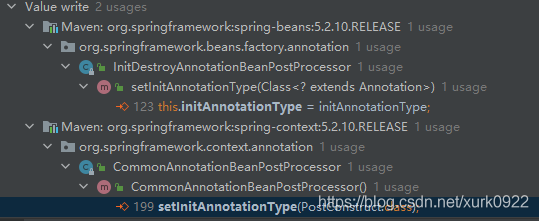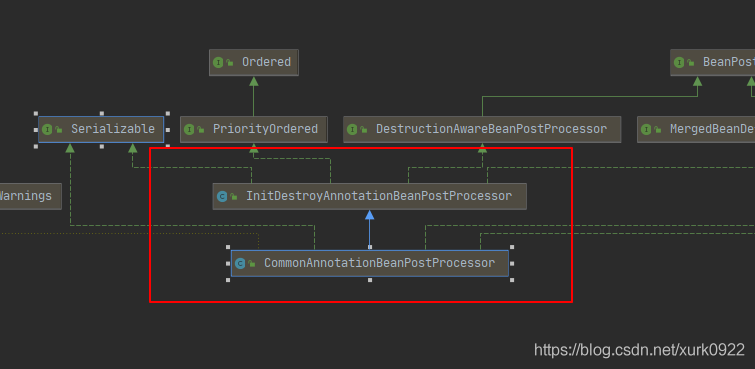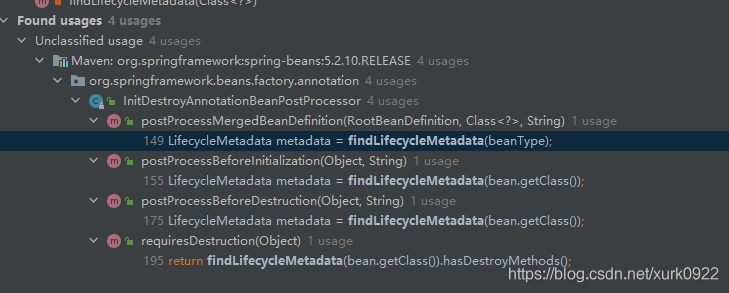жӮЁеҘҪпјҢзҷ»еҪ•еҗҺжүҚиғҪдёӢи®ўеҚ•е“ҰпјҒ
жӮЁеҘҪпјҢзҷ»еҪ•еҗҺжүҚиғҪдёӢи®ўеҚ•е“ҰпјҒ
иҝҷзҜҮж–Үз« дё»иҰҒд»Ӣз»Қ@PostConstructгҖҒafterPropertiesSetе’Ңinit-methodжү§иЎҢйЎәеәҸжҳҜжҖҺж ·зҡ„пјҢж–Үдёӯд»Ӣз»Қзҡ„йқһеёёиҜҰз»ҶпјҢе…·жңүдёҖе®ҡзҡ„еҸӮиҖғд»·еҖјпјҢж„ҹе…ҙи¶Јзҡ„е°Ҹдјҷдјҙ们дёҖе®ҡиҰҒзңӢе®ҢпјҒ
жғіиҰҒзҹҘйҒ“ @PostConstructгҖҒinit-methodгҖҒafterPropertiesSet() зҡ„жү§иЎҢйЎәеәҸпјҢеҸӘиҰҒжҗһжҳҺзҷҪе®ғ们еҗ„иҮӘеңЁд»Җд№Ҳж—¶еҖҷиў«и°Ғи°ғз”Ёе°ұиЎҢдәҶгҖӮ
зЁӢеәҸзүҲжң¬пјҡSpring Boot 2.3.5.RELEASE
еҮҶеӨҮеҘҪиҰҒйӘҢиҜҒзҡ„жқҗж–ҷпјҡ
public class Foo implements InitializingBean {
@Override
public void afterPropertiesSet() throws Exception {
System.out.println("afterPropertiesSet()");
}
@PostConstruct
public void init() {
System.out.println("@PostConstruct");
}
private void initMethod() {
System.out.println("initMethod()");
}
}@Configuration
public class FooConfiguration {
@Bean(initMethod = "initMethod")
public Foo foo() {
return new Foo();
}
}жү§иЎҢеҗҜеҠЁзұ»пјҢеҸҜд»ҘзңӢеҲ°еңЁжҺ§еҲ¶еҸ°дёӯиҫ“еҮәпјҡ
@PostConstruct
afterPropertiesSet()
initMethod()
иҜҙжҳҺжү§иЎҢйЎәеәҸжҳҜпјҡ@PostConstructгҖҒafterPropertiesSet()гҖҒinit-method
жҺҘдёӢжқҘе°Ҷи·ҹзқҖжәҗз ҒжқҘдәҶи§Јдёәд»Җд№ҲжҳҜиҝҷдёӘйЎәеәҸгҖӮ
йҰ–е…ҲпјҢеңЁ init() дёӯжү“дёӘж–ӯзӮ№пјҢ然еҗҺд»Ҙ debug зҡ„ж–№ејҸеҗҜеҠЁйЎ№зӣ®пјҢеҫ—еҲ°дёӢйқўзҡ„и°ғз”Ёж Ҳпјҡ
init:23, Foo (com.xurk.init.foo) invoke0:-1, NativeMethodAccessorImpl (sun.reflect) invoke:62, NativeMethodAccessorImpl (sun.reflect) invoke:43, DelegatingMethodAccessorImpl (sun.reflect) invoke:498, Method (java.lang.reflect) invoke:389, InitDestroyAnnotationBeanPostProcessor$LifecycleElement (org.springframework.beans.factory.annotation) invokeInitMethods:333, InitDestroyAnnotationBeanPostProcessor$LifecycleMetadata (org.springframework.beans.factory.annotation) postProcessBeforeInitialization:157, InitDestroyAnnotationBeanPostProcessor (org.springframework.beans.factory.annotation) applyBeanPostProcessorsBeforeInitialization:415, AbstractAutowireCapableBeanFactory (org.springframework.beans.factory.support) initializeBean:1786, AbstractAutowireCapableBeanFactory (org.springframework.beans.factory.support) doCreateBean:594, AbstractAutowireCapableBeanFactory (org.springframework.beans.factory.support) createBean:516, AbstractAutowireCapableBeanFactory (org.springframework.beans.factory.support) lambda$doGetBean$0:324, AbstractBeanFactory (org.springframework.beans.factory.support) getObject:-1, 2103763750 (org.springframework.beans.factory.support.AbstractBeanFactory$$Lambda$169) getSingleton:234, DefaultSingletonBeanRegistry (org.springframework.beans.factory.support) doGetBean:322, AbstractBeanFactory (org.springframework.beans.factory.support) getBean:202, AbstractBeanFactory (org.springframework.beans.factory.support) preInstantiateSingletons:897, DefaultListableBeanFactory (org.springframework.beans.factory.support) finishBeanFactoryInitialization:879, AbstractApplicationContext (org.springframework.context.support) refresh:551, AbstractApplicationContext (org.springframework.context.support) refresh:143, ServletWebServerApplicationContext (org.springframework.boot.web.servlet.context) refresh:758, SpringApplication (org.springframework.boot) refresh:750, SpringApplication (org.springframework.boot) refreshContext:405, SpringApplication (org.springframework.boot) run:315, SpringApplication (org.springframework.boot) run:1237, SpringApplication (org.springframework.boot) run:1226, SpringApplication (org.springframework.boot) main:14, InitApplication (com.xurk.init)
д»ҺдёҠеҫҖдёӢзңӢпјҢи·іиҝҮдҪҝз”Ё sun.reflect зҡ„ж–№жі•пјҢиҝӣе…ҘеҲ°з¬¬6иЎҢгҖӮ
public void invoke(Object target) throws Throwable {
ReflectionUtils.makeAccessible(this.method);
this.method.invoke(target, (Object[]) null);
}еҫҲжҳҺжҳҫпјҢиҝҷйҮҢжҳҜеңЁйҖҡиҝҮеҸҚе°„и°ғз”ЁжҹҗдёӘеҜ№иұЎзҡ„дёҖдёӘж–№жі•пјҢ并且иҝҷдёӘвҖңжҹҗдёӘеҜ№иұЎвҖқе°ұжҳҜжҲ‘们е®ҡд№үзҡ„ Fooзҡ„е®һдҫӢеҜ№иұЎдәҶгҖӮ
йӮЈд№ҲиҝҷйҮҢзҡ„ method еҸҲжҳҜеңЁд»Җд№Ҳж—¶еҖҷиҝӣиЎҢиөӢеҖјзҡ„е‘ўпјҹ
invoke(...) е…Ёи·Ҝеҫ„жҳҜпјҡ
org.springframework.beans.factory.annotation.InitDestroyAnnotationBeanPostProcessor.LifecycleElement#invoke
并且 LifecycleElement жңүдё”еҸӘжңүдёҖдёӘжҳҫзӨәеЈ°жҳҺ并且еёҰеҸӮж•°зҡ„жһ„йҖ еҷЁпјҢиҝҷдёӘиҰҒдј е…Ҙжһ„йҖ еҷЁзҡ„еҸӮж•°жӯЈжҳҜ invoke(...) дҪҝз”Ёзҡ„йӮЈдёӘ Method еҜ№иұЎгҖӮ
жҺҘдёӢжқҘе°ұжҳҜжҹҘдёҖдёӢпјҢжҳҜи°ҒеңЁ new LifecycleElement гҖӮ
дәҺжҳҜе®ҡдҪҚеҲ°пјҡ
org.springframework.beans.factory.annotation.InitDestroyAnnotationBeanPostProcessor#buildLifecycleMetadata
private LifecycleMetadata buildLifecycleMetadata(final Class<?> clazz) {
if (!AnnotationUtils.isCandidateClass(clazz, Arrays.asList(this.initAnnotationType, this.destroyAnnotationType))) {
return this.emptyLifecycleMetadata;
}
List<LifecycleElement> initMethods = new ArrayList<>();
List<LifecycleElement> destroyMethods = new ArrayList<>();
Class<?> targetClass = clazz;
do {
final List<LifecycleElement> currInitMethods = new ArrayList<>();
final List<LifecycleElement> currDestroyMethods = new ArrayList<>();
ReflectionUtils.doWithLocalMethods(targetClass, method -> {
if (this.initAnnotationType != null && method.isAnnotationPresent(this.initAnnotationType)) {
LifecycleElement element = new LifecycleElement(method);
currInitMethods.add(element);
if (logger.isTraceEnabled()) {
logger.trace("Found init method on class [" + clazz.getName() + "]: " + method);
}
}
if (this.destroyAnnotationType != null && method.isAnnotationPresent(this.destroyAnnotationType)) {
currDestroyMethods.add(new LifecycleElement(method));
if (logger.isTraceEnabled()) {
logger.trace("Found destroy method on class [" + clazz.getName() + "]: " + method);
}
}
});
initMethods.addAll(0, currInitMethods);
destroyMethods.addAll(currDestroyMethods);
targetClass = targetClass.getSuperclass();
}
while (targetClass != null && targetClass != Object.class);
return (initMethods.isEmpty() && destroyMethods.isEmpty() ? this.emptyLifecycleMetadata :
new LifecycleMetadata(clazz, initMethods, destroyMethods));
}第15-26иЎҢжҳҜеңЁйҖҡиҝҮеҸҚе°„еҲӨж–ӯж–№жі•дёҠжҳҜеҗҰеӯҳеңЁжҹҗдёӘжіЁи§ЈпјҢеҰӮжһңжҳҜзҡ„иҜқе°ұеҠ еҲ°дёҖдёӘйӣҶеҗҲдёӯпјҢеңЁжңҖеҗҺз”ЁдәҺжһ„е»ә LifecycleMetadata е®һдҫӢгҖӮ
еңЁиҝҷйҮҢеӣ дёәжҲ‘们иҰҒжҹҘжүҫзҡ„жҳҜиў«иөӢеҖјзҡ„еҶ…е®№пјҢжүҖд»ҘеңЁдҪҝз”ЁIDEиҝӣиЎҢжҹҘжүҫж—¶еҸӘиҰҒе…іжіЁ write зӣёе…ізҡ„еҶ…е®№е°ұиЎҢдәҶгҖӮ

еҲ°иҝҷйҮҢпјҢе·Із»ҸзҹҘйҒ“дәҶжҳҜеңЁ CommonAnnotationBeanPostProcessor зҡ„жһ„йҖ еҷЁдёӯиҝӣиЎҢ set зҡ„пјҢд№ҹе°ұжҳҜеҪ“еҲӣе»ә CommonAnnotationBeanPostProcessor е®һдҫӢзҡ„ж—¶еҖҷе°ұдјҡиҝӣиЎҢиөӢеҖјпјҢ并且 CommonAnnotationBeanPostProcessor жҳҜ InitDestroyAnnotationBeanPostProcessor зҡ„еӯҗзұ»гҖӮ

并且пјҢCommonAnnotationBeanPostProcessor жһ„йҖ еҷЁдёӯи°ғз”Ёзҡ„ setInitAnnotationType е…¶е®һжҳҜе®ғзҲ¶зұ»зҡ„ж–№жі•пјҢе®һйҷ…жҳҜеҜ№ InitDestroyAnnotationBeanPostProcessor зҡ„е®һдҫӢзҡ„ initAnnotationType еӯ—ж®өиҝӣиЎҢиөӢеҖјгҖӮ
еҲ°иҝҷйҮҢе·Із»ҸеҸҜд»ҘжҳҺзЎ® buildLifecycleMetadata(...) дёӯеҲӨж–ӯзҡ„жӯЈжҳҜ @PostConstructгҖӮ
еҶҚеӣһеҲ°buildLifecycleMetadata(...) пјҢжҹҘзңӢе…¶дҪҝз”Ёзҡ„ doWithLocalMethods(...) зҡ„е®һзҺ°гҖӮ
public static void doWithLocalMethods(Class<?> clazz, MethodCallback mc) {
Method[] methods = getDeclaredMethods(clazz, false);
for (Method method : methods) {
try {
mc.doWith(method);
}
catch (IllegalAccessException ex) {
throw new IllegalStateException("Not allowed to access method '" + method.getName() + "': " + ex);
}
}
}еҫҲз®ҖеҚ•пјҢйҖҡиҝҮеҸҚе°„иҺ·еҫ—зұ»зҡ„жүҖжңүж–№жі•пјҢ然еҗҺи°ғз”ЁдёҖдёӘеҮҪж•°жҺҘеҸЈзҡ„ж–№жі•пјҢиҝҷдёӘеҮҪж•°жҺҘеҸЈзҡ„е®һзҺ°е°ұжҳҜеҲӨж–ӯж–№жі•жҳҜдёҚжҳҜиў« @PostConstruct ж ҮжіЁпјҢеҰӮжһңиў«ж ҮжіЁзҡ„иҜқж”ҫеҲ°дёҖдёӘеҗҚеӯ—еҸ« currInitMethods зҡ„йӣҶеҗҲдёӯгҖӮ
зңӢеҲ°иҝҷйҮҢжҲ–и®ёдҪ е·Із»Ҹж„ҸиҜҶеҲ°дәҶпјҢ @PostConstructеҸҜд»Ҙж ҮжіЁеӨҡдёӘж–№жі•пјҢ并且еӣ дёәеҸҚе°„иҺ·еҸ–ж–№жі•ж—¶жҳҜж №жҚ®еЈ°жҳҺйЎәеәҸзҡ„гҖҒ currInitMethods жҳҜ ArrayListпјҢдёӨиҖ…д№Ӣй—ҙзҡ„йЎәеәҸжҳҜдёҖж ·зҡ„гҖӮ
еҘҪдәҶпјҢиў« @PostConstruct ж ҮжіЁзҡ„ж–№жі•е·Із»ҸжүҫеҲ°ж”ҫеҲ°йӣҶеҗҲдёӯдәҶпјҢе°Ҷиў«з”ЁжқҘжһ„е»ә LifecycleMetadata е®һдҫӢдәҶгҖӮ
buildLifecycleMetadata(...) ж–№жі•иҝ”еӣһдёҖдёӘ LifecycleMetadata е®һдҫӢпјҢиҝҷдёӘиҝ”еӣһеҖјдёӯеҢ…еҗ«дј е…ҘClassе®һдҫӢдёӯеҫ—еҲ°зҡ„жүҖжңүиў« @PostConstruct ж ҮжіЁзҡ„ Method е®һдҫӢпјҢжҺҘдёӢжқҘиҰҒзңӢзңӢжҳҜи°ҒеңЁи°ғз”Ё buildLifecycleMetadata(...) ж–№жі•пјҢзңӢзңӢе®ғжҳҜжҖҺд№Ҳз”Ёзҡ„пјҹ
иҝҪжәҜеҲ° findLifecycleMetadata(...) иҖҢ findLifecycleMetadata(...) еҸҲжңүеҘҪеҮ еӨ„иў«и°ғз”ЁгҖӮ

жҹҘзңӢжңҖж—©еҫ—еҲ°зҡ„ж–№жі•и°ғз”Ёж ҲпјҢжҹҘеҲ°postProcessBeforeInitializatio(...) пјҢе®ғеҸҲжҳҜеҶҚиў«и°Ғи°ғз”Ёпјҹ
init:23, Foo (com.xurk.init.foo) invoke0:-1, NativeMethodAccessorImpl (sun.reflect) invoke:62, NativeMethodAccessorImpl (sun.reflect) invoke:43, DelegatingMethodAccessorImpl (sun.reflect) invoke:498, Method (java.lang.reflect) invoke:389, InitDestroyAnnotationBeanPostProcessor$LifecycleElement (org.springframework.beans.factory.annotation) invokeInitMethods:333, InitDestroyAnnotationBeanPostProcessor$LifecycleMetadata (org.springframework.beans.factory.annotation) postProcessBeforeInitialization:157, InitDestroyAnnotationBeanPostProcessor (org.springframework.beans.factory.annotation) applyBeanPostProcessorsBeforeInitialization:415, AbstractAutowireCapableBeanFactory (org.springframework.beans.factory.support) initializeBean:1786, AbstractAutowireCapableBeanFactory (org.springframework.beans.factory.support)
и·ҹзқҖж–№жі•и°ғз”Ёж ҲпјҢжҲ‘们жқҘеҲ°
org.springframework.beans.factory.support.AbstractAutowireCapableBeanFactory#applyBeanPostProcessorsBeforeInitialization
@Override
public Object applyBeanPostProcessorsBeforeInitialization(Object existingBean, String beanName)
throws BeansException {
Object result = existingBean;
for (BeanPostProcessor processor : getBeanPostProcessors()) {
Object current = processor.postProcessBeforeInitialization(result, beanName);
if (current == null) {
return result;
}
result = current;
}
return result;
}еңЁиҝҷдёӘж–№жі•пјҢйҒҚеҺҶ BeanPostProcessors йӣҶеҗҲ并жү§иЎҢжҜҸдёӘ BeanPostProcessor зҡ„ postProcessBeforeInitialization(...) ж–№жі•гҖӮ
**йӮЈд№Ҳ getBeanPostProcessors() дёӯзҡ„еҶ…е®№еҸҲжҳҜеңЁд»Җд№Ҳж—¶еҖҷж”ҫиҝӣеҺ»зҡ„е‘ўпјҹйғҪжңүе“ӘдәӣеҶ…е®№пјҹ**еҸҜд»ҘйҖҡиҝҮ AnnotationConfigUtilsе’Ң CommonAnnotationBeanPostProcessor жҹҘжүҫпјҢиҝҷйҮҢе°ұдёҚеҶҚиөҳиҝ°дәҶгҖӮ
жҹҘжүҫ applyBeanPostProcessorsBeforeInitialization(...) зҡ„и°ғз”ЁиҖ…пјҢжқҘеҲ°
org.springframework.beans.factory.support.AbstractAutowireCapableBeanFactory#initializeBean
protected Object initializeBean(String beanName, Object bean, @Nullable RootBeanDefinition mbd) {
if (System.getSecurityManager() != null) {
AccessController.doPrivileged((PrivilegedAction<Object>) () -> {
invokeAwareMethods(beanName, bean);
return null;
}, getAccessControlContext());
}
else {
invokeAwareMethods(beanName, bean);
}
Object wrappedBean = bean;
if (mbd == null || !mbd.isSynthetic()) {
wrappedBean = applyBeanPostProcessorsBeforeInitialization(wrappedBean, beanName);
}
try {
invokeInitMethods(beanName, wrappedBean, mbd);
}
catch (Throwable ex) {
throw new BeanCreationException(
(mbd != null ? mbd.getResourceDescription() : null),
beanName, "Invocation of init method failed", ex);
}
if (mbd == null || !mbd.isSynthetic()) {
wrappedBean = applyBeanPostProcessorsAfterInitialization(wrappedBean, beanName);
}
return wrappedBean;
}йЎҫеҗҚжҖқд№үпјҢеңЁиҝҷдёӘж–№жі•дёӯеҜ№ Bean иҝӣиЎҢеҲқе§ӢеҢ–гҖӮжҳҜеңЁиў«жіЁе…ҘеүҚдёҖе®ҡиҰҒз»ҸиҝҮзҡ„иҝҮзЁӢпјҢеҲ°иҝҷйҮҢиў« @PostConstruct ж ҮжіЁзҡ„ж–№жі•жү§иЎҢе·Із»Ҹе®ҢжҲҗдәҶгҖӮиҮідәҺиҝҷдёӘж–№жі•и°Ғи°ғз”ЁеҸҜд»ҘиҮӘе·ұжҹҘзңӢи°ғз”Ёж ҲгҖӮ
з»Ҷеҝғзҡ„жңӢеҸӢеҸҜиғҪе·Із»ҸеҸ‘зҺ°дәҶеңЁ initializeBean(...) дёӯжңүи°ғз”ЁеҲ°дёҖдёӘеҸ«еҒҡ invokeInitMethods(...) зҡ„ж–№жі•гҖӮ
protected void invokeInitMethods(String beanName, Object bean, @Nullable RootBeanDefinition mbd)
throws Throwable {
boolean isInitializingBean = (bean instanceof InitializingBean);
if (isInitializingBean && (mbd == null || !mbd.isExternallyManagedInitMethod("afterPropertiesSet"))) {
if (logger.isTraceEnabled()) {
logger.trace("Invoking afterPropertiesSet() on bean with name '" + beanName + "'");
}
if (System.getSecurityManager() != null) {
try {
AccessController.doPrivileged((PrivilegedExceptionAction<Object>) () -> {
((InitializingBean) bean).afterPropertiesSet();
return null;
}, getAccessControlContext());
}
catch (PrivilegedActionException pae) {
throw pae.getException();
}
}
else {
((InitializingBean) bean).afterPropertiesSet();
}
}
if (mbd != null && bean.getClass() != NullBean.class) {
String initMethodName = mbd.getInitMethodName();
if (StringUtils.hasLength(initMethodName) &&
!(isInitializingBean && "afterPropertiesSet".equals(initMethodName)) &&
!mbd.isExternallyManagedInitMethod(initMethodName)) {
invokeCustomInitMethod(beanName, bean, mbd);
}
}
}BeanDefinitionжҳҜBeanе®ҡд№үзҡ„дёҖдёӘжҠҪиұЎгҖӮзұ»дјјдәҺеңЁJavaдёӯеӯҳеңЁClassзұ»з”ЁдәҺжҸҸиҝ°дёҖдёӘзұ»пјҢйҮҢйқўжңүдҪ е®ҡд№үзҡ„ Bean зҡ„еҗ„з§ҚдҝЎжҒҜгҖӮ
еңЁз¬¬4иЎҢпјҢеҲӨж–ӯжҳҜдёҚжҳҜ InitializingBeanпјҢеҰӮжһңжҳҜзҡ„иҜқдјҡиҝӣиЎҢзұ»еһӢејәиҪ¬пјҢ然еҗҺи°ғз”Ё afterPropertiesSet()гҖӮ
еңЁз¬¬26иЎҢпјҢиҺ·еҫ—еҲ°иҮӘе®ҡд№үеҲқе§ӢеҢ–ж–№жі•зҡ„еҗҚеӯ—пјҢ然еҗҺеңЁз¬¬30иЎҢи°ғз”Ё invokeCustomInitMethod жү§иЎҢе®ҢжҲҗгҖӮ
protected Object initializeBean(String beanName, Object bean, @Nullable RootBeanDefinition mbd) {
if (System.getSecurityManager() != null) {
AccessController.doPrivileged((PrivilegedAction<Object>) () -> {
invokeAwareMethods(beanName, bean);
return null;
}, getAccessControlContext());
}
else {
invokeAwareMethods(beanName, bean);
}
Object wrappedBean = bean;
if (mbd == null || !mbd.isSynthetic()) {
wrappedBean = applyBeanPostProcessorsBeforeInitialization(wrappedBean, beanName);
}
try {
invokeInitMethods(beanName, wrappedBean, mbd);
}
catch (Throwable ex) {
throw new BeanCreationException(
(mbd != null ? mbd.getResourceDescription() : null),
beanName, "Invocation of init method failed", ex);
}
if (mbd == null || !mbd.isSynthetic()) {
wrappedBean = applyBeanPostProcessorsAfterInitialization(wrappedBean, beanName);
}
return wrappedBean;
}initializeBean(...) ж–№жі•дёӯпјҢе…Ҳжү§иЎҢ applyBeanPostProcessorsBeforeInitialization(...) еңЁжү§иЎҢ invokeInitMethods(...) гҖӮ
иҖҢ applyBeanPostProcessorsBeforeInitialization(...) дјҡжү§иЎҢиў« @PostConstruct ж ҮжіЁзҡ„ж–№жі•пјҢinvokeInitMethods(...) дјҡжү§иЎҢ afterPropertiesSet() е’ҢиҮӘе®ҡд№үзҡ„еҲқе§ӢеҢ–ж–№жі•пјҢ并且 afterPropertiesSet() еңЁиҮӘе®ҡд№үзҡ„еҲқе§ӢеҢ–ж–№жі•д№ӢеүҚжү§иЎҢгҖӮ
жүҖд»Ҙе®ғ们д№Ӣй—ҙзҡ„жү§иЎҢйЎәеәҸжҳҜпјҡ
@PostConstruct > afterPropertiesSet() > initMethod()
д»ҘдёҠжҳҜвҖң@PostConstructгҖҒafterPropertiesSetе’Ңinit-methodжү§иЎҢйЎәеәҸжҳҜжҖҺж ·зҡ„вҖқиҝҷзҜҮж–Үз« зҡ„жүҖжңүеҶ…е®№пјҢж„ҹи°ўеҗ„дҪҚзҡ„йҳ…иҜ»пјҒеёҢжңӣеҲҶдә«зҡ„еҶ…е®№еҜ№еӨ§е®¶жңүеё®еҠ©пјҢжӣҙеӨҡзӣёе…ізҹҘиҜҶпјҢж¬ўиҝҺе…іжіЁдәҝйҖҹдә‘иЎҢдёҡиө„и®Ҝйў‘йҒ“пјҒ
е…ҚиҙЈеЈ°жҳҺпјҡжң¬з«ҷеҸ‘еёғзҡ„еҶ…е®№пјҲеӣҫзүҮгҖҒи§Ҷйў‘е’Ңж–Үеӯ—пјүд»ҘеҺҹеҲӣгҖҒиҪ¬иҪҪе’ҢеҲҶдә«дёәдё»пјҢж–Үз« и§ӮзӮ№дёҚд»ЈиЎЁжң¬зҪ‘з«ҷз«ӢеңәпјҢеҰӮжһңж¶үеҸҠдҫөжқғиҜ·иҒ”зі»з«ҷй•ҝйӮ®з®ұпјҡis@yisu.comиҝӣиЎҢдёҫжҠҘпјҢ并жҸҗдҫӣзӣёе…іиҜҒжҚ®пјҢдёҖз»ҸжҹҘе®һпјҢе°Ҷз«ӢеҲ»еҲ йҷӨж¶үе«ҢдҫөжқғеҶ…е®№гҖӮ